

Explore the different sections below to understand what teenagers may be going through during adolescence, what constitutes their identity, as well as why and how they may strive to forge their sense of identity!
Adolescent Development. What is adolescence?
Teenagers begin to undergo puberty and experience diverse changes. These changes can range from physical (growing in size and height) to emotional (activation of sexual hormones), as well as cognitive (becoming more self-conscious and engaging in arguments). – tzx1
Adolescence is the period of transition between childhood and adulthood.
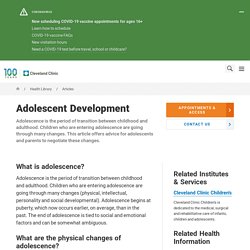
Children who are entering adolescence are going through many changes (physical, intellectual, personality and social developmental). Adolescence begins at puberty, which now occurs earlier, on average, than in the past. The end of adolescence is tied to social and emotional factors and can be somewhat ambiguous. Cleveland Clinic is a non-profit academic medical center. Stages of Adolescence.
By: Brittany Allen, MD, FAAP & Helen Waterman, DO Adolescence is the period of transition between childhood and adulthood.
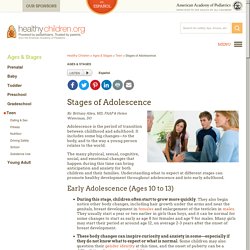
It includes some big changes—to the body, and to the way a young person relates to the world. The many physical, sexual, cognitive, social, and emotional changes that happen during this time can bring anticipation and anxiety for both children and their families. Understanding what to expect at different stages can promote healthy development throughout adolescence and into early adulthood.
Early Adolescence (Ages 10 to 13)
According to Erik Erikson, self-identity refers to the consistency of our individuality, interpersonal attitude, and commitments to roles, values, and beliefs. Erikson referred to the sense of identity as the "identity of the ego" - the sense of identity that is strengthened through the resolution of conflicts in each psychosocial stage. Erikson believed that identity is fundamentally a construct of both individual and communal aspects, in which people form through adopting different social roles. Explore the rest of the section to discover more about how our sense of identity is formed! References: Côté, J. E. (2009). Identity formation and self-development in adolescence. In R. M. Lerner & L. Steinberg (Eds.), Handbook of adolescent psychology: Individual bases of adolescent development (p. 266–304). John Wiley & Sons Inc. – tzx1
Adolescent Identity Development - Adolescence - ACT for Youth. The development of a strong and stable sense of self is widely considered to be one of the central tasks of adolescence [1].
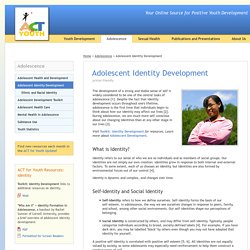
Despite the fact that identity development occurs throughout one's lifetime, adolescence is the first time that individuals begin to think about how our identity may affect our lives [2]. During adolescence, we are much more self-conscious about our changing identities than at any other stage in our lives [3]. Visit Toolkit: Identity Development for resources. Learn more about Adolescent Development. What Is Self-Concept and How Does It Form? Self-concept is the image that we have of ourselves.
Identity formation also involves the development of a stronger self-concept. Self-concept refers to the set of beliefs about ourselves and revolves around the notion of "Who Am I?". This involves how we see ourselves (self-image), how much we like ourselves (self-esteem), and "Who Do I Want To Be?" (ideal self). Identity formation is, therefore, the process of redefining oneself through self-exploration during adolescence. This process typically occurs during the stage of identity versus role confusion. Check out the following video on how identities are constructed! You may also learn more about what identity versus role confusion means, as well as why and how they may strive to form identities, in the next section below! – tzx1
How exactly does this self-image form and change over time?

This image develops in a number of ways but is particularly influenced by our interactions with important people in our lives. What Is Self-Concept? Self-concept is how you perceive your behavior, abilities, and unique characteristics.1 For example, beliefs such as "I am a good friend" or "I am a kind person" are part of an overall self-concept. Self-concept tends to be more malleable when you're younger and still going through the process of self-discovery and identity formation. How Our Identities Are Socially Constructed.
Self-identity is fundamentally the social construct of everyone's effort - it is who we meet and interact with; dynamic and ever-improving. – tzx1
The process of identity development begins as early as childhood, through adolescence, and even continues to evolve throughout adulthood. To maintain our sense of identity, Erikson proposed that there are eight different psychosocial stages that we ought to overcome. You may learn more about these eight psychosocial stages through the web pages and videos as you continue to explore this section, as well as why and how teenagers strive to forge a sense of identity during adolescence! References: Sokol, J. T. (2009). Identity development throughout the lifetime: An examination of Eriksonian theory. Graduate journal of counseling psychology, 1(14), 1-11. – tzx1
Erik Erikson's 8 Stages of Psychosocial Development. Erik Erikson was an ego psychologist who developed one of the most popular and influential theories of development.
The theory of psychosocial development encompasses eight sequential stages. In each of these stages, a conflict arises to be resolved. By successfully resolving these conflicts, individuals learn to strengthen their sense of identity as they progress further through the different stages. The fifth psychosocial stage: identity versus role confusion, describes the period of adolescence. Teenagers in this stage will begin to question "Who Am I?" and "Who Do I Want To Be?" due to the cognitive and emotional changes that occur during the onset of puberty. For example, they may start to think more abstractly and become more self-conscious about themselves. Thus, they seek to forge a stronger sense of identity so that they can develop a deeper meaning of their role beyond the context of schools to fit in society. – tzx1
While his theory was impacted by psychoanalyst Sigmund Freud's work, Erikson's theory centered on psychosocial development rather than psychosexual development. The stages that make up his theory are as follows:1. Gender Identity in Adolescent Development. Gender Identity Andi isn't alone in what she's going through.
In the process of redefining their identity, teenagers will cycle through several identities that suit them best. For instance, they may choose to explore different identity roles such as gender identities, cultural identities, ethnic identities, or even professional identity. Additionally, the goal of strengthening the sense of identity during this period is essentially vital because it allows teenagers to develop a stable self-concept needed to overcome the conflict in the next psychosocial stage - forming intimate relationships. Check out the following short video as it summarises the stage of identity vs. role confusion! – tzx1
As children turn into adolescents, they begin to question what it means to be part of their gender, and some adolescents find that their gender and their sex organs don't match up, as with Andi.
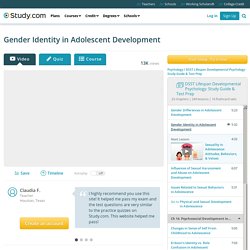
Identity vs. Role Confusion. How to Support Your Teen’s Identity. The main developmental task for young people is to figure out who they are and where they fit in in the world.

Teenagers are learning how to be an adult and this transition can include becoming more independent, looking for new experiences, developing their values and exploring sexual identity and romantic relationships. While teenagers do rely heavily on peer approval, their parents’ opinions still carry weight well into adulthood. Adolescents in foster care may find this task especially difficult because of the added stress of not living with their biological family. How Parents Can Help Their Teenager Form a Positive Self-Identity. Though it can be hard for parents to let go and acknowledge their teen needs external help, a credible adventure therapy program can relatively quickly and positively change your son or daughter’s life for the better.
Parents can also share constructive ways in handling disappointments as teenagers go about making independent decisions. More importantly, the goal is to maintain boundaries with them as you communicate care and support. This provides a sense of assurance and trust, as well as respect for who they are becoming. – tzx1
Psychologist Erik Erikson advocated that teen identity development is fostered by experiences that allow individuals to express their individuality and receive feedback and validation from others.
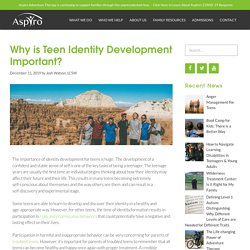
Adventure therapy programs provide experiences that promote healthier relationships and positive identity formation in teens. Supporting your child's development through puberty. Identity Development Throughout the Lifetime An Examination of Eriksonian Theory. Handbook of Adolescent Psychology.